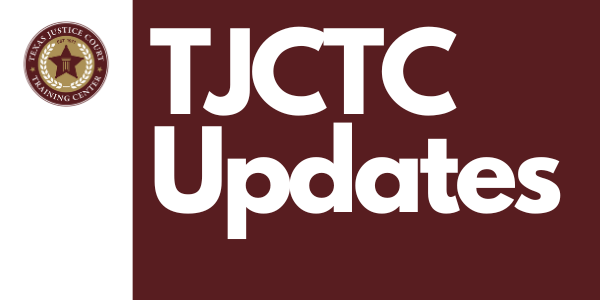
Registration Updates & More!
You should have received an email earlier today about registration for legislative updates. If you missed it, you can view it online.
This is a short update with reminders for upcoming online programs. Don’t forget to scroll to the bottom to hear about the updated SRL Page.

Updated Moving Violation Link
The link for the chart of Moving Violations has been updated. This is the list courts use to determine Driving Safety Course eligible offenses for defendants under the age of 25.
The new link is Figure: 37 TAC §15.89(b).
TJCTC materials will be updated later this year to include this new link and other legislative changes.

Legal Question of the Month
Question: Under Texas law, can a claimant recover damages for negligence if they are more than 50% at fault, and how is their recovery affected if they are partially at fault?
Answer: No, under Section 33.001 of the Texas Civil Practice and Remedies Code, a claimant may not recover damages if their percentage of responsibility is greater than 50%. If the claimant is 50% or less at fault, they may recover damages, but under Section 33.012(a), the amount is reduced by their percentage of responsibility. The process of assigning percentage of liability is called Modified Comparative Negligence or Proportionate Responsibility.
This is a question for the jury to answer in a jury trial and TJCTC has a special verdict form that can be used if it is a questions. The jury cannot be advised about any consequences of their answers related to proportionate responsibility.
Do you want to learn more?
You can watch the recording for credit: How Much Should the Judgement Be? Calculating Damages in Civil Cases for more information.

Webinar from State Bar Justice Court Section: Repair and Remedy and Repair and Deduct Claims in Justice Courts
Friday, April 25, 2025, Noon – 1 pm
This session will offer 1 hour MCLE credit. After registering, you will receive a confirmation email with a link to join the webinar.
Course Description: This presentation will provide a statutory and procedural overview of Repair and Remedy and Repair and Deduct claims, both governed by Chapter 92, Subchapter B of the Texas Property Code, in Justice Courts. Additionally, this presentation will review relevant caselaw related to Repair and Remedy and Repair and Deduct claims and further provide practical considerations and best practices.
We hope to see you in attendance!
Instructors: Marisela Gonzales and Stuart Campbell
Note: This is not a TJCTC sponsored webinar, but from a section of the Texas State Bar Association.
Register for the webinar: https://us06web.zoom.us/meeting/register/9tGEclvBQ7-SRjE9A6MuvA#/registration

Upcoming TJCTC Webinars

Law & Literature Webinar **THIS WEEK**
April 10th from 2:00 – 3:00 pm
Do you want to get paid to be part of a book club? Join TJCTC’s webinar to discuss the book “Maid” that intersects the art of storytelling and the legal field.
Judge Brad Cummings from Hopkins County and TJCTC Attorney John Lackey will lead the discussion regarding the book. Also, feel free to watch the Netflix series based on the book and be ready share your thoughts!
Register for the webinar: https://txstate.zoom.us/webinar/register/WN_Er9LPQhaTl2jltrLKgyicQ#/registration

Clearing Your Docket While Helping Your Community: An Update
June 5th from 2:00 – 4:00 pm
This webinar will be an overview of strategies to clear criminal case dockets while ensuring that indigent defendants’ rights are protected.
It will include information about Omnibase holds, waiver of fines and fees, community service plans, other indigent assistance strategies, and include relevant legislative updates.
Register for the webinar: https://txstate.zoom.us/webinar/register/WN_spcexLIFROSVykhcZrpsZg#/registration

Updated SRL Page
We made some updates and added a few more resources. Make sure you take a look and feel free to share with people who come to your court looking for assistance.
Note: There are several great videos about court procedures from the National Center for State Courts and the Austin Young Lawyers Association available there now as well.
Check out the SRL Page: https://www.tjctc.org/srl.html







